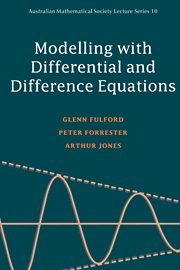Book contents
- Frontmatter
- Contents
- Preface
- Introduction to the student
- Part One Simple Models in Mechanics
- Part Two Models with Difference Equations
- 7 Difference equations
- 8 Linear difference equations in finance and economics
- 9 Non-linear difference equations and population growth
- 10 Models for population genetics
- Part Three Models with Differential Equations
- Part Four Further Mechanics
- Part Five Coupled Models
- References
- Index
7 - Difference equations
Published online by Cambridge University Press: 05 June 2012
- Frontmatter
- Contents
- Preface
- Introduction to the student
- Part One Simple Models in Mechanics
- Part Two Models with Difference Equations
- 7 Difference equations
- 8 Linear difference equations in finance and economics
- 9 Non-linear difference equations and population growth
- 10 Models for population genetics
- Part Three Models with Differential Equations
- Part Four Further Mechanics
- Part Five Coupled Models
- References
- Index
Summary
The quantities involved in mechanics — such as displacement, velocity and acceleration — are typically related to time by smooth functions defined on an entire interval. Problems in mechanics lead, via Newton's second law, to differential equations. By way of contrast, the mathematical models to be studied in this part of the course involve quantities whose values are known only at certain specified times, equally spaced. Such quantities are expressed as functions of the time via sequences. The assumptions in the models can then be expressed as difference equations for these sequences. The difference between models leading to differential equations and those leading to difference equations is often expressed by saying that the former are continuous whereas the latter are discrete.
This chapter introduces the idea of a difference equation via a problem involving rabbit populations. Basic ideas regarding the solutions of these equations are then explained.
Introductory example
Leonardo of Pisa, or Fibonacci as he was better known, is often claimed to be the greatest mathematician of the Middle Ages. His book, Liber abaci, completed in 1202, took advantage of the Hindu–Arabic numerals. Among the problems which the book contains, the one of greatest interest to later mathematicians is as follows:
How many pairs of rabbits will be produced in a year, beginning with a single pair, if every month each pair produces a new pair, which becomes productive two months after birth?
- Type
- Chapter
- Information
- Modelling with Differential and Difference Equations , pp. 105 - 125Publisher: Cambridge University PressPrint publication year: 1997

